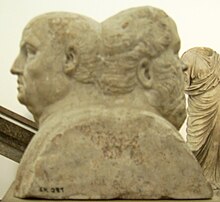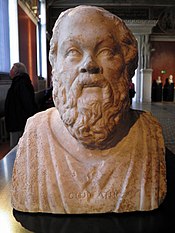Double term for Socrates and Seneca
The Roman Double Herm of Socrates and Seneca from the first half of the 3rd century now part of the collection of antiquities in Berlin .
The double herme was found in 1813 on the Caelius in Rome , on the grounds of the Villa Mattei / Villa Celimontana near the church of S. Maria in Domnica , in 1878 it was acquired by Wolfgang Helbig for the Berlin museums . After the Second World War , the piece was exhibited in the Pergamon Museum until the two Berlin antique collections were merged and reorganized as part of the reunification , and since then in the Altes Museum am Lustgarten .
The double hermitage in Berlin is of particular importance for research, since it is here that the only reliable portrait of Seneca can be assigned. The assignment is based on a Latin inscription on the right side of the bust (seen from Seneca), Socrates is identified by an inscription in Greek. The assignment to Socrates can be seen as certain by further portraits of Socrates, even if many other portraits are less coarse. The Seneca portrait, on the other hand, is now used to identify other portraits and statues. Both philosophers are connected at the back of the head, the chest parts are cut into a hermen shape. Double herms were a repeatedly recurring form of representation in ancient art. In Greece they were exhibited in public spaces, in the Roman Empire in private spaces. Thus, the combination of the two philosophers is due to the client's personal inclinations, even if it is not clear why these two philosophers were connected. It may have something to do with her death from poison. The presentation of philosophers in double terms, like that of poets, was the most common form of this art form. The presentation opposite is also known from literature, for example in the form of Plutarch's double biographies .
Both men have a coat that is customary for philosophers and rhetoricians over their left shoulders ; Socrates also wears an undergarment. The bearded Socrates is, as it is known from written tradition and from other portraits, represented in satyr-like form. Seneca, on the other hand, is shown shaved and with a bald head. His forehead is furrowed because of the wide open eyes and the raised eyebrows. The small, full-lipped mouth is embedded deep in the face. It is believed that the Seneca image goes back to a work that was created between the years 50 and 60, i.e. during the philosopher's lifetime.
literature
- Socrates and Seneca . In: Königliche Museen zu Berlin (Ed.), Alexander Conze (preliminary work): Description of the ancient sculptures with the exclusion of the Pergamene finds . Spemann, Berlin 1891, urn : nbn: de: bsz: 16-diglit-34567 , pp. 158–159 No. 391.
- Max Kunze : Doppelherme des Socrates and Seneca , in: Staatliche Museen zu Berlin Prussian cultural heritage. Antikensammlung (Ed.): The Antikensammlung in the Pergamon Museum and in Charlottenburg . Zabern, Mainz 1992, ISBN 3-8053-1187-7 , pp. 215f.
Web links
- Complete catalog of the sculptures of the Antikensammlung Berlin in the archaeological database Arachne
Remarks
- ↑ Inventory number SK 391 (R 106).
Coordinates: 52 ° 31 '15 " N , 13 ° 23' 47" E


